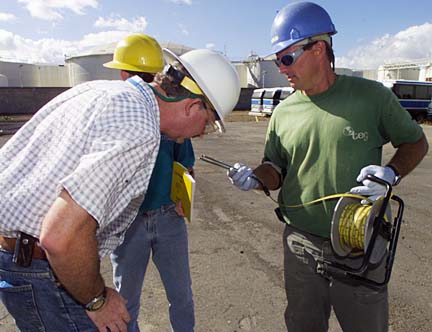


Group to fund Just how much petroleum product is lurking in the soil, the ground water and the abandoned underground pipelines of Iwilei? That is the question.
Iwilei oil tests
An island coalition is trying to
assess the petroleum threat
near Honolulu HarborBy Diana Leone
dleone@starbulletin.comTo find the answer, a consultant supervised by the state Health Department and the federal Environmental Protection Agency will be collecting soil and water samples from 100 acres mauka of Honolulu Harbor over the next two months.
Twelve current and former land users in the area will pay for the venture, said Mike Pitta, project manager for the Honolulu Harbor Participating Parties, the name the coalition gave itself.
The area to be tested includes all land between the harbor and Dillingham Boulevard that is between Kapalama Canal and Nuuanu Stream. On the waterfront, that area includes the land portions of Piers 17 through 39.
The area has been under investigation by the Health Department for some time because of recurring oil sheens in the harbor, the source of which has not been located.
State officials are concerned that redevelopment of Honolulu Harbor is being slowed by the pollution, which has cropped up in several instances, including building of the Home Depot store and the state's new fishing village.
Members of the Honolulu Harbor Participating Parties are: the state Transportation Department, BHP, Chevron, Hawaiian Electric, Shell Oil/Equilon Enterprises, Tosco/Unocal, Castle & Cooke, City Mill Co., the DIL Trust, Phillips Petroleum Co. and Texaco Inc.
The companies hope that by pooling their resources they will be able to restore the environment more economically, said Steve Calanog, EPA on-scene coordinator for the project.
"Releasing oil into water is against the law," Calanog said. The amount that is harmful to marine organisms is the same amount that makes a visible sheen, he said. So if there's a sheen, there's a problem.
Calanog said he expected about 100 soil samples, taken at depths of 10 to 12 feet, will be needed. He expects laboratory tests on the samples to show what kinds of petroleum products are in the ground. Among the possibilities are crude oil, gasoline, diesel and jet fuel.
Then the project will move into the cleanup phase.
"The Honolulu Harbor project is anticipated to be one of the largest and most extensive environmental cleanups in the state's history," according to a Health Department release.
Calanog said EPA supervisors will be on the site daily.
"I don't believe, given our level of oversight, that there would be any opportunities to generate false information or not uncover information," he said. "I believe the companies involved have a sincere intent to uncover what's going on here."